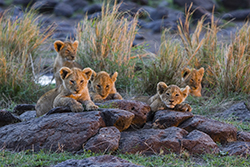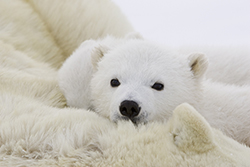
|
|
 |
||||||||||||||||||||
|
|
|||||||||||||||||||||
|
A PHOTOGRAPHIC MEMORY Wildlife Photographer Suzi Eszterhas Shares Some of Her Favorite Moments  By Erin Caslavka It isn’t every day that a wildlife photographer snaps a photo destined to become an iconographic representation of a world in peril. But that’s just what respected nature photographer Suzi Eszterhas did when she shot a picture that ended up on the cover of TIME Magazine’s Special Issue: The Global Warming Survival Guide. On the cover of that publication, a lone penguin stands atop an ice floe, silhouetted against the stark background of a white-on-white world. His head is turned sideways as if in an apparent effort to answer the question: ‘Where do I go from here?’ But even if the iconic penguin doesn’t know the answer to that particular riddle, Eszterhas seems to: she remains actively engaged in her own personal pursuit of photographic excellence, and is simultaneously committed to sharing her love of the wild with others who want to develop their own photographic skills. ARK & TENT caught up with Ms. Eszterhas in her home in Northern California, days before a scheduled return to the African savannah where she spends half her time. A&T: Do you have ‘favorite’ animals you like to photograph? Eszterhas: I’d have to say that big cats are my favorite, but I also find smaller carnivores - those that are less glamorous - fascinating and more challenging. In particular jackals,  foxes and hyenas are intriguing; they’re shy and accustomed to being ignored (by humans) or harassed (by other large carnivores). Conversely, lions, cheetahs and tigers - though more dramatic - are used to being pursued by humans with cameras, and they could care less about us being there. foxes and hyenas are intriguing; they’re shy and accustomed to being ignored (by humans) or harassed (by other large carnivores). Conversely, lions, cheetahs and tigers - though more dramatic - are used to being pursued by humans with cameras, and they could care less about us being there. A&T: Jackals? I don’t think most people would even be able to picture one. Eszterhas: I really fell in love with them. I spent five months with one family, and it took me 17 days to get my first photo. I had to habituate them to my presence, so I’d start out far away and then every day move closer to them so they got used to me. Ethically, you don’t want to harass the animals you’re working with. And artistically, if they’re freaked out by your presence you get that bug-eyed look so common in shots of seals. But once you’ve earned an animal’s trust, they give you a window into their lives. A&T: Have you always wanted to be a photographer? Eszterhas: As a kid, I knew exactly what I wanted to do. I worked as a PR consultant at an animal shelter in Santa Cruz, and as a photographer on the other days. It’s very difficult to break into the field, and it’s extremely competitive - so shooting stock photos is also a part of my photographic work. A&T: Do most animal photographers get ‘lucky’ when they get that one-great-shot, or is it skill, or both? Ezsterhas: It’s a combination. If the animals don’t perform, you’re screwed. But it’s also putting in the time. “Portraits” are what most people shoot, but real behavior you get by spending time with the animals. My best-selling print is of a lion and his cub.  That shot came after two months. The mother had taken her babies out to meet the rest of the pride, and I was there when it happened. But if you’re not putting in the time, you’re not going to get the shot. And that can be intimidating sometimes for beginning photographers who think, “I can’t spend 17 days getting an animal to trust me or get used to my presence.” That shot came after two months. The mother had taken her babies out to meet the rest of the pride, and I was there when it happened. But if you’re not putting in the time, you’re not going to get the shot. And that can be intimidating sometimes for beginning photographers who think, “I can’t spend 17 days getting an animal to trust me or get used to my presence.”A&T: What kind of research do you do before you go on photo safaris? Eszterhas: Knowing your subject is critical, so whenever I set off on a project I read animal behavioral guides and books. Having some knowledge of an animal’s behavior going in is important. For example, knowing which way an animal is likely to go based on the direction of the wind. If you know your subject, you’ll know that if you look at a female animal’s nipples you’ll be able to tell if she’s got babies who are suckling.  And asking questions, too: Why is she watching that bush? Are there newborns hidden there? And asking questions, too: Why is she watching that bush? Are there newborns hidden there?The best thing about wildlife is that the animals are unpredictable. Some of these animals are on hunting blocks, where there’s active hunting going on and they really fear humans; so they can be either shy, or aggressive. The grizzly bear is a good example of that dichotomy: they’re in an area of hunting, and are extremely dangerous. A&T: With all the time you spend in the wild, you must have some heroes - or those you admire. Eszterhas: When there are people - individuals - who have truly dedicated their lives to a cause, I admire that. Corporations and non-profits tend to get caught up in bureaucracy, but those who are “on the ground,” the ones doing local work, they really make the most difference. The Cheetah Conservation Fund, founded by Dr. Laurie Marker, is a good example. They work with local farmers to provide stock-protection dogs to safeguard livestock. So in that way, they’re helping to preserve the local wild population. Another example is work that’s being done in Northern Kenya. All hunting is banned in Kenya, but the Grevy’s zebra - of which there are only about 3,000 left - is critically endangered. They are very water-dependent, and end up competing for water with the people who live in the same area. So people were chasing  the zebras away from their watering holes. the zebras away from their watering holes.In response, local NGOs have put in water wells for locals to use so they have regular access to clean drinking water that’s set apart from the wildlife. A&T: There seems to be a photographer’s creed as regards not interfering with the way that nature plays itself out. Have you ever felt compelled to become involved to the point where you were ‘altering fate’? Eszterhas: I’ve seen entire liters be wiped out and it’s heartbreaking. In one instance, I watched five babies from one family die over the course of 19 days. But there are exceptions to the “don’t get involved” rule. For example, there are anti-poaching efforts in most African nations. So if an animal is ensnared in a trap, I don’t have a problem with someone setting it free. After all, traps are man-made; not a result of w hat happens in nature... When it’s an endangered species, I do think there’s an ethical responsibility to help. But there are times when you can’t help but get involved. A lion cub  I was watching was really manhandling this tortoise. After he’d finished toying with it, it was left upside down; but otherwise, it was fine. So I got out of the car and rolled it over. The purist wouldn’t have done that - but I wouldn’t have been able to sleep knowing I’d left it there baking in the sun. I was watching was really manhandling this tortoise. After he’d finished toying with it, it was left upside down; but otherwise, it was fine. So I got out of the car and rolled it over. The purist wouldn’t have done that - but I wouldn’t have been able to sleep knowing I’d left it there baking in the sun.A&T: Is there a country you prefer for getting the best wildlife photographs? Eszterhas: Botswana has a wealth of species. The presence of predator and prey creates huge drama, so it’s a place I take people to every year. It’s a fantastic place, and they have a very unique conservation model. They’ve set aside alot of land that’s privately owned, with high-end camps that only accommodate a limited number of people. It’s unfortunate that it’s so expensive, and it brings up the issue of: are we making this affordable to only the really wealthy? But wildlife is a commodity, and these are private concessions wherein people have to make a living and be provided with an incentive to protect their wildlife resources. A&T: What makes a good photograph ‘great’? Eszterhas: The moment that’s captured. Whether it’s something completely new and unique, or a “normal” moment portrayed in a special way. There’s also something very compelling about the savage side of life; it’s powerful. A leopard leaping captures that. The vulnerability of the young does, too, as does the  vulnerability of a particular species. Gorillas remind me of the effect that the clash of humanity has on a non-human scale. There are so few of them left, and they live in an area torn apart by war. So without human protection, they’d have absolutely no chance of survival. vulnerability of a particular species. Gorillas remind me of the effect that the clash of humanity has on a non-human scale. There are so few of them left, and they live in an area torn apart by war. So without human protection, they’d have absolutely no chance of survival.A&T: What’s the best advice you could give a beginning photographer? Eszterhas: People just getting into photography can be really intimidated at first, but wildlife is so accessible these days that it’s a great time to go. And beginning photographers are refreshing because they’re so enthusiastic about what they’re trying to learn. Most people are just doing it as a hobby, but if they’re passionate about it, that’s what counts. Photo credits: ALL IMAGES COPYRIGHT SUZI ESZTERHAS www.suzieszterhas.com |
|
|
|
|
| Site Map |